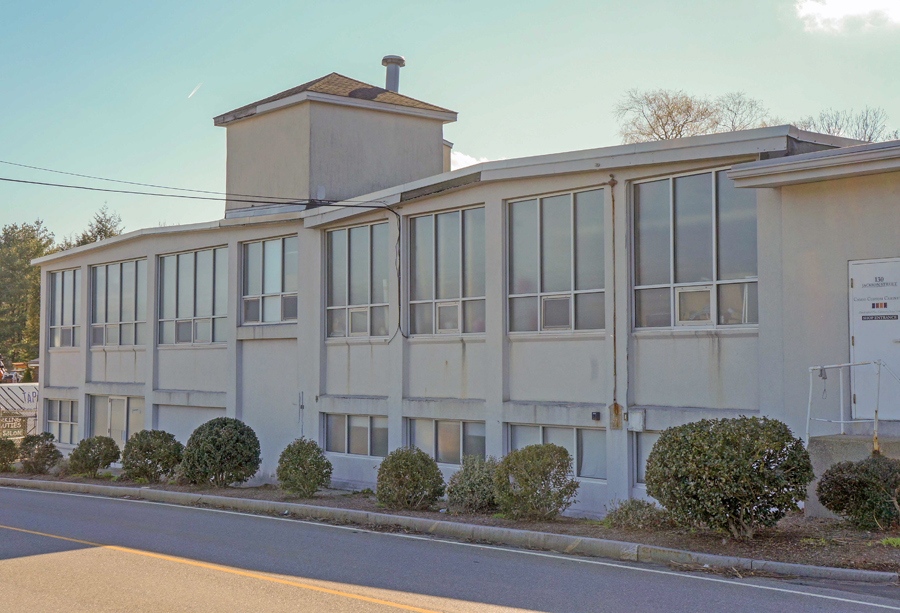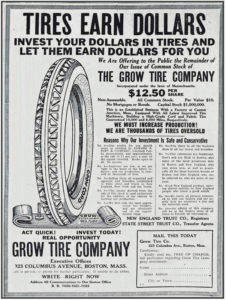True Tales: Grow Tires & Stock Options
By George T. ComeauGeorge Grow was a natural-born salesman. In the Roaring Twenties, Grow had become very wealthy selling used cars. Through his connections, he would network with wealthy men selling their cars, and men on the way up the ladder purchasing the cars. Grow never spoke of his family background, and all outward appearances led his customers to believe that he was a solid man of integrity.
Perhaps it was the fact that Grow was Jewish and he wanted to hide that fact from people. Late 19th and early 20th-century Boston was deeply divided between the old Boston Brahmin families who controlled the social, cultural, and financial institutions, and the Irish who rose at the time to become a force in politics. The lines had been drawn, and this did not make it easy for the largely immigrant Jewish community to find a recognized place.
Grow’s father was listed in the 1880 census as a “huckster” and a street directory of the time listed him as a “peddler.” Whatever his work, we do know that his name was Benjamin S. Grodginsky and he was born in Russian-occupied Poland. Grodginsky died in Chelsea on January 23, 1896, in a railroad accident in which his body was “badly mutilated.” George saw how his father was treated and wanted to remove the stigma of being Jewish. George and his brother Samuel took up the surname Grow and started a company together.
There are literally hundreds of advertisements that peppered the Boston Globe for years on end. The earliest advertisements began popping up in 1911. George Grow & Company was located on Worcester Street in the South End of Boston. The deals abounded — for a mere $500 you could purchase a four-cylinder Oldsmobile Roadster with a rumble seat and top. At $250 a Ford Touring car with seating for four and a 25-horsepower engine had a top speed of 40 miles per hour and featured five lights and a gas generator. By 1916, the George Grow Automobile Co. was the largest used car business in the world, or so his advertisement proclaimed. With an inventory of over 500 cars, business was booming. Yes, Grow could sell cars, and the more cars he sold, the more he saw that the future was in rubber tires. That future included Canton in a big way.
Early wheels on cars were predictably born from the wheels on carts and wagons. Eventually, leather was added, and then solid rubber became the material of choice. In all these early cases, the ride was hard and rough and each bump was absorbed through the car frame and into the bottoms of the riders. In time, vehicle tires became pneumatic. Made up of an inner tube that contained compressed air and an outer casing, the casing became the tire. The casing protected the inner tube and provided the tire with traction. Layers called plies reinforced the casing. The plies were made of rubberized fabric or linen cords that were embedded in the rubber and the tires were known at the time as “bias ply tires.” Grow came to understand that he could make a fortune manufacturing rubber tires. By the early 1920s there were more than 400 companies manufacturing tires in the United States, and Grow wanted to be the biggest.
In the spring of 1919, Grow launched the George Grow Tire Company. Working out of his car showroom at Columbus Avenue in Boston, he began to look for a suitable place to manufacturer his tires. Canton was a natural choice. There was the fact that the Plymouth Rubber Company was already here, so that meant a workforce was well educated in the materials and the methods of production. Also, a large factory had just become available adjacent to Canton Junction.
In the late 1800s the Cornelius C. Callahan Fire Hose Company operated out of a new building at the intersection between Wattles, Jackson and Chapman streets. In the building that still stands today was the company that revolutionized seamless cotton fire hoses. Callahan had a number of critical patents that are the bases for today’s fire hose shutoffs as well as the weaving of jersey cloth. As Callahan grew older and closer to retirement, the business interests changed. By 1919 the building was available and it was a perfect location and fit-out for George Grow.
Production at the two-acre site in Canton began in July and 50 tires were manufactured daily. Later that year the output ramped up dramatically, with more than 200 tires rolling into box cars and being shipped out each day. Since the rubber was plied with fabric, the former cotton fire hose machinery likely played a role in the material inside the Grow tires. These were high quality products of which they made one model from cord and anther from Egyptian-combed cotton fabric. Grow guaranteed the wear of up to eight thousand miles and their tires became known for their quality. Most large cities in Massachusetts had a Grow Tire dealer. And within a short time, that became true up and down the Eastern seaboard. The biggest benefit in Canton was access to more than 125 skilled laborers that became the Grow workforce.
With an initial capitalization and a stock offering to all of George Grow’s friends and clients, the company issued $1,000,000, all of which was common stock. By 1920, U.S. Investor Magazine took notice and ran a headline, “George Grow Tire Company — Expanding Plant to Meet Increased Demand for Tire.” The industry was diversifying, and America was falling in love with the automobile. George Grow, who could sell cars and tires, now needed to sell investors, and that would prove to be a daunting task.
The story that ran in 1920 was rather bullish on Grow: “A Boston tire company which has [seen] rapid progress in the past few is the George Grow Tire Company. In addition to a selling organization the company has a factory at Canton Junction Mass which now makes 150 to 200 tires daily. These have been widely sold and the company is now enlarging its plant to meet the demand. It is expected new machinery will be installed within two months which will double production and incidentally reduce the average of overhead expense per tire thus increasing the profit on each unit. The George Grow Tire Company is a Massachusetts corporation capitalized for $1,000,000 divided into shares $10 par. About 70,000 shares are outstanding and the balance is sold to provide for the enlarged manufacturing plant. We understand that no reclaimed rubber is used in the Grow Tire. Both the cord and ordinary tires are made of the best materials, and by experienced workmen, with the result that only moderate advertising has been found necessary to dispose of all the tires that can be made, and to create a demand which the increased facilities will not fill. There is an excellent opportunity for a well-managed company, putting out a satisfactory tire, to show consistent profits and under these conditions the outlook for George Grow Tire is promising.”
A follow-up story in Indian Rubber World Magazine was equally laudatory. “The factory at Canton Junction is producing 600 tires weekly and as this output is consistently oversold the capacity will be increased to 6,000 tires weekly. The firm’s product is marketed through a chain of stores operating in many leading New England cities.” With all this good press, the stocks should have sold out.
By 1923, Grow Tire expanded their headquarters in Boston. And yet they failed to raise the needed capital to expand, and so the following year they went into receivership and ended production. The investors never flocked to Grow, and the assets were sold to a rival tire company. The factory never missed a beat, as Plymouth Rubber took over the building and switched the machines from making tires to making rubber rain coats. George Grow lived in a stately home in Chestnut Hill and died in 1962. He is buried with his brother and father in Tifereth Israel Cemetery in West Roxbury. The factory still stands today as a hidden reminder of the entrepreneurial spirit of George Grow.
Short URL: https://www.thecantoncitizen.com/?p=54200












